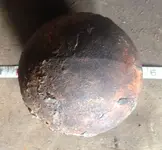Upnorth42
Full Member
- Joined
- Sep 26, 2014
- Messages
- 138
- Reaction score
- 184
- Golden Thread
- 0
- Location
- Nova Scotia
- Detector(s) used
- AT PRO
- Primary Interest:
- All Treasure Hunting
Hello All:
Is this a cannon ball or something else? It was found in a barn in Ireland. I'm not sure if cannon balls have seams. Could it be from a ball mill or something like that? Its about 5.5" in diameter and weighs about 12 pounds.
Its not mine or found by me I'm posting for a friend who is curious about what it might be.
Thanks
Is this a cannon ball or something else? It was found in a barn in Ireland. I'm not sure if cannon balls have seams. Could it be from a ball mill or something like that? Its about 5.5" in diameter and weighs about 12 pounds.
Its not mine or found by me I'm posting for a friend who is curious about what it might be.
Thanks




